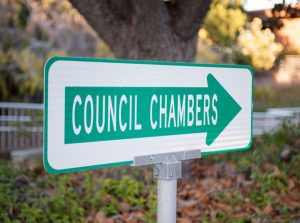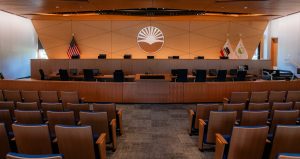The Santa Clara Charter Review Committee won’t complete its recommendation about the city’s election system on Oct. 11, 2011 as initially planned. At its Sept. 22 meeting, the committee scheduled three additional two-hour meetings – Sept. 29, Oct. 13, and Oct. 27 – and hasn’t set a date for its report to the Santa Clara City Council.
“It’s unrealistic to think that you can deal with such important issues in 90 minutes,” observed committee member Vilma Palette, in proposing the longer meetings.
With the first two meetings of the committee given over almost completely to policy and procedure discussions – and possibly one of the most painstaking analyses of California’s Brown Act to ever take place outside the state capital – and Thursday’s meeting to presentations from the county registrar of voters and Santa Clara’s “ethics and values” consultant, inaction was clearly making committee members restless.
“We’ve been meeting for three meetings, and we haven’t had any discussion,” noted one at Thursday’s meeting – no doubt expressing what many were thinking. “I was hoping to see an agenda item [labeled] ‘committee discussion.'”
Chicken or Egg – System Flaws or Disengaged Voters?
Tom Shanks, Santa Clara University professor of communication and former director of SCU’s Markkula Center for Applied Ethics was on the agenda to provide “the viewpoint of a reasonable, average person” on the fairness of Santa Clara’s current at-large elections. These include keeping elections focused on larger citywide (rather than neighborhood) issues, a more responsive Council because everyone is a constituent, and higher engagement on the part of voters.
But if this is the case, committee member Ralph Sivilla wanted to know why Santa Clara’s elected representatives weren’t more, well, representative.
“One of the main issues that brings us here is a lack of minority representation. If the electoral system is not a problem,” he asked Shanks, “why are we having a problem getting minorities on the City Council?” Outreach and education are needed, Shanks replied.
“So you’re saying that the problem isn’t the system, it’s [voter] engagement?” asked committee member Eric Stroker.
Election Mechanics – You Can’t Get There From Here
The other business of the meeting was hearing from two representatives of the county registrar of voters about the mechanics of different types of election systems.
Santa Clara could switch to a district system at a minimal cost, Registrar Elaine Larsen told the committee. However, the county’s current voting machines cannot handle cumulative, proportional, or ranked choice/instant-runoff voting.
Larsen noted that county voters had approved a 1998 measure to allow ranked choice voting, but so far no Santa Clara County city has implemented it. If Santa Clara was first in using this method, the city would be the “investing jurisdiction” – in other words, Santa Clara would have to pay the entire cost of making the change.
And those costs are high, according to county Election Services Coordinator Philip Chantri. Alameda County spent between $1.2 million and $1.5 million to convert Alameda’s, Berkeley’s and Oakland’s voting systems to ranked choice.
Further, chaning the system to ranked choice voting must be approved by the county board of supervisors. In addition the Sequoia voting machines currently in use would have to be upgraded and certified for use by the California Secretary of State, and the city would have to undertake substantial outreach and education for both voters and election officials.
The change “wouldn’t happen in 2012,” Larsen added.
Steve Chessin, President of Californians for Electoral Reform (www.cefr.org), urged the committee against ruling out ranked choice voting solely on the basis of cost, noting that while Sequoia’s equipment isn’t certified for ranked choice voting, other manufacturers’ is. Further, Chessin noted, other cities such as Portland, OR have outsourced the management of entire elections, with an overall reduction in the cost of conducting elections.
The Term Limits Elephant in the Committee Room
Despite explicit directions given to the Charter Review Committee that its mission is solely to evaluate Santa Clara’s at-large election system and recommend whether changes should be made, committee members don’t necessarily see Santa Clara’s term limits as an unrelated issue.
Committee members declined to comment on this directly, but discussion last Thursday might indicate that they haven’t shelved the topic. No insight was offered by the city’s ethics consultant on how a “reasonable, average person” might view Santa Clara’s revolving door term limits.
Upcoming Charter Review Committee Meetings are scheduled Sept. 29, Oct. 13, and Oct 27, 2011 in the City Council Chambers from 5:30- 7:30 p.m. The community is encouraged to attend and participate in the discussion. You can review committee activity by visiting santaclaraca.gov, selecting the What’s New tab, and scrolling down the news page to select “Charter Review Committee Binder.”











0 comments